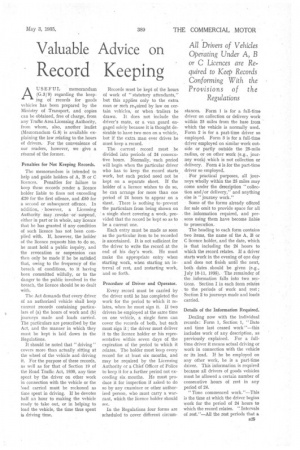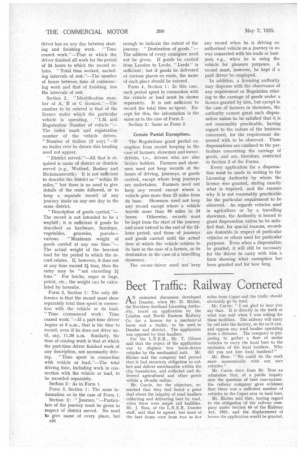Valuable Advice on
Page 39

Page 40

If you've noticed an error in this article please click here to report it so we can fix it.
Record Keeping
AUSEFUL memorandum (G.3/9) regarding the keeptrig of records for goods vehicles has been prepared by the Ministry of Transport, and copies can be obtained, free of charge, from any Traffic Area Licensing Authority, from whom, also, another leaflet (Memorandum G.8) is available explaining the law relating to the hours of drivers. For the convenience of our readers, however, we give a résumé of the former.
Penalties for Not Keeping Records.
The memorandum is intended to help and guide holders of A, B or C licences. Penalties for failure to keep these records render a licence holder liable to fines not exceeding £20 for the first offence, and £50 for a second or subsequent offence. In addition, however, a Licensing
• Authority. May ,revoke or suspend, either in part or in whole, any licence that he has granted if any condition of such licence has not been complied with. If, however, the holder of the licence requests him to do so, he must hold a public inquiry, and the revocation or suspension can then only be made if he be satisfied that, owing to the frequency of the breach of conditions, to it having been committed wilfully, or to the danger to the public involved in the breach, the licence should be so dealt with,
The Act demands that every driver of an authorized vehicle shall keep current records containing particulars of (a) the hours of work and (b) journeys made and loads carried. The particulars are prescribed by the Act, and the manner in which they must be kept is laid down in the Regulations.
It should be noted that "driving covers more than actually sitting at the wheel of the vehicle and driving it. For the purpose of these records, as well as for that of Section 19 of the Road Traffic Act, 1930, any time spent by the driver on other work in connection with the vehicle or the load carried must he reckoned as time spent in driving. If he devotes half an hour to making the vehicle ready to take out, or in helping to load the vehicle, the time thus spent is driving time. Records must be kept of the hours of work of " statutory attendants," but this applies only to the extra man or meh reyuired by law on certain vehicles, or when trailers be drawn. It does not include the driver's mate, or a van guard engaged solely because it is thought desirable to have two men on a vehicle, but if the extra man ever drives he must keep a record.
The current record must be divided into periods of 24 consecutive hours. Normally, each period will begin when the particular driver who has to keep the record starts. work, but each period need not be kept on a separate sheet. If the holder of a licence wishes to do so, he can arrange for more than one period of 24 hours to appear on a sheet. There is nothing to prevent the particulars from being shown on a single sheet covering a week, provided that the record be kept so as to be a current one.
Each entry must be made as soon as the particular item to be recorded is ascertained. It is not sufficient for the driver to write the record at the end of his day's work. He must make the appropriate entry when starting work, when starting an interval of rest, and restarting work, and so forth.
Procedure of Driver and Operator.
Every record must be carried by the driver until he has completed the work for the period to which it relates, when he must sign it. If two drivers be employed at the same time on one vehicle, a single form can cover the records of both, but each must sign it ; the driver must deliver it to the licence holder or his representative within seven days of the expiration of the period to which it relates. The holder must keep every record for at least six months, and may be required by the Licensing Authority or a Chief Officer of Police to keep it for a further period not exceeding six months. He must produce it for inspection if asked to do so by any examiner or other authorized person, who must carry a warrant, which the licence holder should see.
In the Regulations four forms are scheduled to cover different circurn stances. Form 1 is for a full-time driver on collection or delivery work within 25 miles from the base from which the vehicle is normally used. Form 2 is for a part-time driver so employed. Form 3 is for a full-time driver employed on similar work outside or partly outside the 25-mile radius, or on other work (e.g., journey work) which is not collection or delivery. Form 4 is for the part-time driver so employed.
For practical purposes, all journeys wholly within the 25 miles may come under the description "collection and/or delivery," and anything else is "journey work."
Some of the forms already offered for sale omit to provide space for all the information required, and persons using them have become liable to prosecution.
The heading to each form contains two items, the name of the A, B or C licence holder, and the date, which is that including the 24 hours to which the record relates. If a driver starts work in the evening of one day and does not finish until the next, both dates should be given (e.g., July 10-11, 1935). The remainder of the .information falls into two sections. Section 1 in each form relates to the periods of work and rest; Section 2 to journeys made and loads carried.
Details of the Information Required.
Dealing now with the individual records: Form 1, Section 1, "Date and time last ceased work "—this includes work of any description, as previously explained. For a fulltime driver it means actual driving or work in connection with the vehicle or its load. If he be employed on any other work, he is a part-time driver. This information is required because all drivers of goods vehicles must be allowed a certain number of consecutive hours of rest in any period of 24.
"Time commenced work."—This is the time at which the driver begins work for the period of 24 hours to which the record relates. "Intervals of rest."—All the rest periods that a
driver has on any day between starting and finishing work. "Time
ceased work."—That at which the driver finished all work for the period of 24 hours to which the record relates. " Total time worked, excluding intervals of rest."—The number of hours between time of commencing work and that of finishing, less the intervals of rest.
Section 2. "Identification number of A, B or C licences."—The number to be entered is that of the licence under which the particular vehicle is operating. " I.M. and Registration Number of vehicle."-The index mark and registration number of the vehicle driven. "Number of trailers (if any)."—If no trailer ever be drawn this heading
need not appear. • "District served."—All that is required is name of district or districts served (e.g., Watford, Bushey and Rickmansworth). It is not sufficient to describe the district as "within 25 miles," but there is no need to give details of the route followed, or to keep a separate record of any journey made on any one day in the same district.
"Description of goods carried."— The record is not intended to be a waybill it is sufficient if goods be described as hardware, furniture, vegetables, groceries, parcels— various. "Maximum weight of goods carried at any one time.' 'The actual weight of the heaviest load for the period to which the record relates. If, however, it does not at any time exceed 21 tons, then the entry may be "not exceeding 21 tons." For bricks, sugar in bags, petrol, etc., the weight can be calculated by formula.
Form 2, Section I: The only difference is that the record must show separately total time spent in connection with the vehicle or its load. "Time commenced work : Time ceased work."—If a part-time driver begins at 8 a.m., that is the time to record, even if he does not drive until, say, 11.30 a.m. Similarly, the time of ceasing work is that at which the part-time driver finished work of any description, not necessarily driving. "Time spent in connection with vehicle or load."—The total driving time, including work in connection with the vehicle or load, to be recorded separately.
Section 2: As in Form 1.
Form 3, Section 1: The same information as in the case of Form _1.
Section 2: " Journey."—Particulars of the journey must be given in respect of district served. No need to give name of every place, but enough to indicate the extent of the journey. "Destination of goods."— The address of every consignee need• not be given. If goods be carried from London to Leeds, "Leeds" is sufficient ; but if goods be delivered at various places en route, the name of each place should be entered.
Form 4, Section 1: In this case, each period spent in connection with the vehicle or load must be shown separately. It is not sufficient to record the total time so spent. Except for this, the information is the same as in the case of Form 2.
Section 2: Same as Form 3.
Certain Partial Exemptions.
The Regulations grant partial exemption from record keeping in the case of farmers, showmen and ownerdrivers, i.e., drivers who are also licence holders. Farmers and showmen need not keep records of the hours of driving, journeys, or goods carried, except where long journeys are undertaken. Farmers need not keep any record except where a vehicle goes more than 25 miles from its base. Showmen need not keep any record except where a vehicle travels more than 50 miles in 24 hours. Otherwise, records must be kept from the start of the journey and must extend to the end of the 24hour period; and those of journeys and goods carried until the actual time *at which the vehicle returns to its base in the case of a farmer, or its destination in the case of a travelling showman.
The owner-driver need not keep any record when he is driving an authorized vehicle on a journey in no way connected with his trade or business, e.g., when he is using the vehicle for pleasure purposes. A record must, however, be kept if a paid driver be employed.
In addition, a licensing authority may dispense with the observance of any requirement or Regulation relating to the carriage of goods under a licence granted by him, but except in the case of farmers or showmen, the authority cannot grant such dispensation unless he be satisfied that it is not reasonably practicable, having regard to the nature of the business concerned, for the requirement dispensed with to be observed. These dispensations are confined to the particulars concerning the carriage of goods, and are, therefore, restricted to Section 2 of the Forms.
Every application for a dispensation must be made in writing to the Licensing Authority by whom the licence was granted, stating exactly what is required, and the reasons why it is not reasonably practicable for the particular requirement to be observed. As regards vehicles used in agriculture or by a travelling showman, the Authority is bound to grant dispensation unless he be satisfied that, for special reasons, records are desirable _in respect of particular vehicles or others used for particular purposes. Even when a dispensation be granted, it will still be necessary for the driver to carry with him a form showing what exemption has been granted and for how long.




























































































